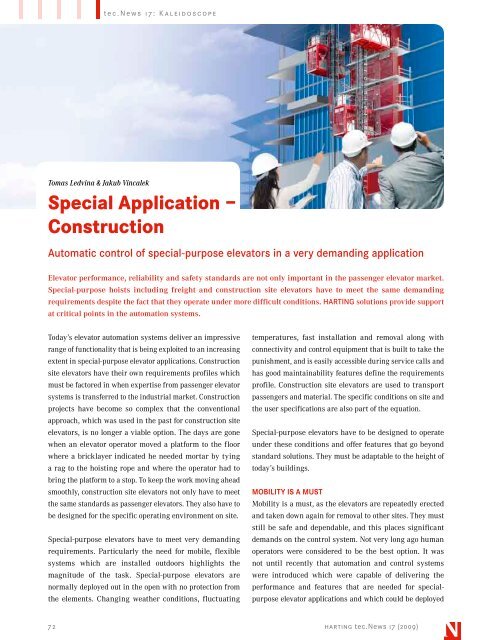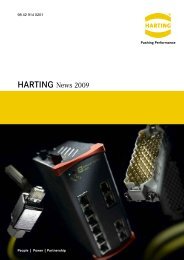Download - Harting
Download - Harting
Download - Harting
Create successful ePaper yourself
Turn your PDF publications into a flip-book with our unique Google optimized e-Paper software.
tec.News 17: Kaleidoscope<br />
Tomas Ledvina & Jakub Vincalek<br />
Special Application –<br />
Construction<br />
Automatic control of special-purpose elevators in a very demanding application<br />
Elevator performance, reliability and safety standards are not only important in the passenger elevator market.<br />
Special-purpose hoists including freight and construction site elevators have to meet the same demanding<br />
requirements despite the fact that they operate under more difficult conditions. HARTING solutions provide support<br />
at critical points in the automation systems.<br />
Today’s elevator automation systems deliver an impressive<br />
range of functionality that is being exploited to an increasing<br />
extent in special-purpose elevator applications. Construction<br />
site elevators have their own requirements profiles which<br />
must be factored in when expertise from passenger elevator<br />
systems is transferred to the industrial market. Construction<br />
projects have become so complex that the conventional<br />
approach, which was used in the past for construction site<br />
elevators, is no longer a viable option. The days are gone<br />
when an elevator operator moved a platform to the floor<br />
where a bricklayer indicated he needed mortar by tying<br />
a rag to the hoisting rope and where the operator had to<br />
bring the platform to a stop. To keep the work moving ahead<br />
smoothly, construction site elevators not only have to meet<br />
the same standards as passenger elevators. They also have to<br />
be designed for the specific operating environment on site.<br />
Special-purpose elevators have to meet very demanding<br />
requirements. Particularly the need for mobile, flexible<br />
systems which are installed outdoors highlights the<br />
magnitude of the task. Special-purpose elevators are<br />
normally deployed out in the open with no protection from<br />
the elements. Changing weather conditions, fluctuating<br />
temperatures, fast installation and removal along with<br />
connectivity and control equipment that is built to take the<br />
punishment, and is easily accessible during service calls and<br />
has good maintainability features define the requirements<br />
profile. Construction site elevators are used to transport<br />
passengers and material. The specific conditions on site and<br />
the user specifications are also part of the equation.<br />
Special-purpose elevators have to be designed to operate<br />
under these conditions and offer features that go beyond<br />
standard solutions. They must be adaptable to the height of<br />
today’s buildings.<br />
Mobility is a must<br />
Mobility is a must, as the elevators are repeatedly erected<br />
and taken down again for removal to other sites. They must<br />
still be safe and dependable, and this places significant<br />
demands on the control system. Not very long ago human<br />
operators were considered to be the best option. It was<br />
not until recently that automation and control systems<br />
were introduced which were capable of delivering the<br />
performance and features that are needed for specialpurpose<br />
elevator applications and which could be deployed<br />
72 harting tec.News 17 (2009)





